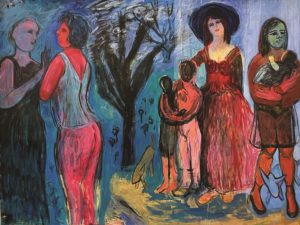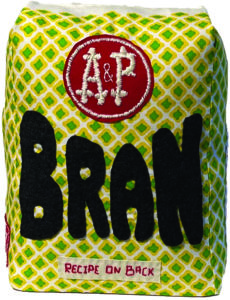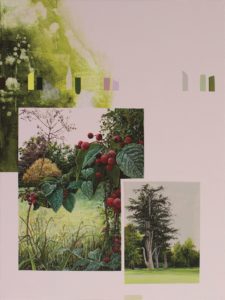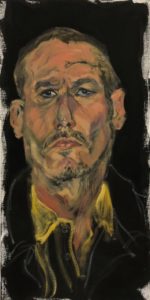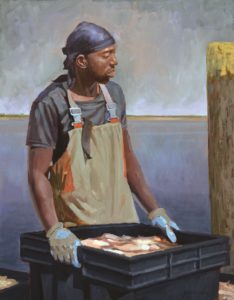On a summer morning in Provincetown, the door of Joerg Dressler’s Pleasant Street studio is wide open, easing the boundary between the controlled calm inside and the rhythms of pedestrians crossing between Commercial and Bradford streets. Light pours into the space through skylights. Dressler’s paint tubes are neatly ordered by color, and the wooden floor, splattered with paint, traces Dressler’s history here where he has been painting since 2001.
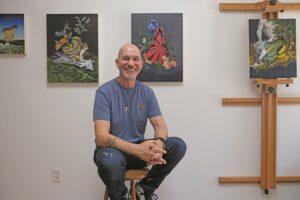
The paintings on the walls span changes in his career, including an early atmospheric oil, a landscape with a three-dimensional mountain-like form, and several paintings in a style for which he is perhaps most known, in which realistic snippets of landscapes — often sourced from photographs Dressler takes while traveling — float in hard-edged abstract spaces, interrupted with splotches of color.
On one wall is a new body of work he will be showing at Alden Gallery. He started the paintings in Miami, where he lives in the winter, but his inspiration is more local.
“I wanted to bring in the experience of Provincetown but without the expected things,” he says. “But I think I lost track of that.” There are elements of the world right outside his door in these paintings, particularly in the imagery of water and male bodies on display. But Dressler moved freely in a variety of directions in this work, incorporating images from art history and cutting into the surfaces of the paintings to create a level of abstract patterning below the surface.
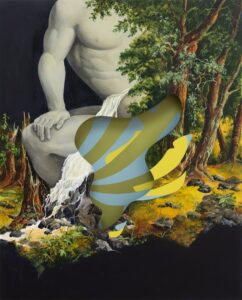
“I’m solving problems that I posed myself,” says Dressler, noting the incorporation of human figures — something new for him — and the merging of two-dimensional and three-dimensional spaces in this latest body of work.
In addition to painting, Dressler works as a freelance graphic designer — a job that involves its own kind of problem solving. “In graphic design you’re ultimately answering questions, and in art you’re asking the questions,” says Dressler.
In 2001, when Dressler bought the house in Provincetown, he was working full-time designing a visual brand for a company in Boston. But with an art studio at his disposal, he cut his day job down to four days a week to devote more time to painting.

“I’m not going to wait until retirement to paint again, I thought,” says Dressler, who graduated from art school in 1994 in Germany, where he grew up. In 2014, he left his job to devote himself more fully to painting, but the experience of thinking as a graphic designer continues to inform his approach to painting, both as a source of influence and opposition.
Dressler’s process owes a lot to graphic design, although his use of color is another story (“God forbid you use pink or muted colors in graphic design,” he says). Cutting and pasting visual elements together — so central to graphic design — is how Dressler begins a painting. Consequently, his paintings have a collage-like aesthetic, where the relationship among elements is surprising and stilted, without any deference to a traditional painting space that favors a unified whole.
For his painting Salty Sailor, Dressler began creating the image in Photoshop, working with a photograph of his cat and still-life elements lifted from a painting by the Dutch artist Willem van Aelst.
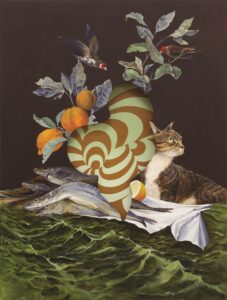
“I’m not replicating what I’m seeing,” he says. “I’m interpreting it in a way that I need for my work.” He pulls in diverse elements to meet the needs of his composition. In this case, a group of leaves helps activate the right-hand corner of the painting, and a passage of green water, which he painted from imagination, grounds the bottom third of the painting.
In planning a painting, personal stories often lead the way. “My own personal story allows me to come up with the ideas and the elements,” says Dressler. He wonders, however, how important those stories are to the viewer’s experience.
“I wouldn’t want a story to oversell the work,” he says. “I sometimes hear artists talking about their work and it all makes sense and it’s a great story but then I look at the work and it doesn’t show.”
After a bit of questioning, Dressler opens up about the narrative behind his painting Stud, a picture of a gecko climbing up a leg surrounded by multi-colored flowers. Like the other paintings in this series, an abstract aberration literally cuts through the center of the picture.
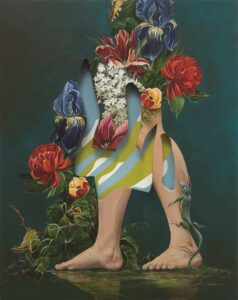
“As a kid, I looked like a girl, and I behaved like a girl,” says Dressler. “As an adult I don’t feel or look that way but there’s a feminine component in me.” He understands this painting as a personal commentary on gender stereotypes. “Even though you have a feminine side, you can still be entirely a man and be a stud and not be fazed by a little gecko crawling up your legs,” he says.
The legs in this painting are culled from Caravaggio, and they aren’t the only element influenced by the 16th-century Italian. Dressler’s lush flowers and dramatic palette reverberate with Caravaggio’s sensuality and chiaroscuro lighting.
Art history figures prominently in Dressler’s work. “I spent a lot of time as a teenager in Paris,” he says. “My stepfather took me to all the museums, and at the end of each visit he would buy me a book.”
In Rabbit Hole, Dressler picks up on the conventions and themes of historic still life painting, albeit with a black-and-red pattern at its center that nods more to op-art. In the painting’s imagery of fruit, Dressler locates both sensuality and mortality. “The fruit are symbols of juiciness and youth but also impermanence,” says Dressler. “The passage of time is an important component of my work.”
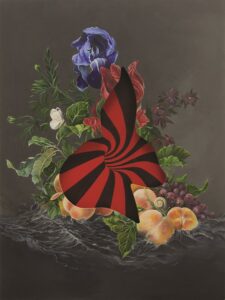
Another key idea is humans’ relationship to nature. “If the work resonates with a viewer, they will recognize my love for nature,” says Dressler, who hopes that his paintings allow viewers “to look at nature in a different way and think about their relationship to nature.”
Dressler starts each day with walking. “It grounds me and humbles me,” he says. In his paintings, however, nature is more distant and stylized: trees, turbulent seas, and flowers become visual symbols filtered through the synthetic processes of photography, design, and painting. Plus “there’s always the element of disruption that I’m after,” says Dressler. In the past it might have been splotches of spilled paint or the intrusion of flat, abstract shapes. In this latest body of work, the disruptions are shapes cut into the panels and the abstract patterns underneath.
It’s Dressler’s use of stylization and disruption that articulates his commentary on humanity’s relationship to nature. There’s beauty here — that’s for sure — but unlike the porous relationship between nature and individuals championed by transcendentalists and Romantics, Dressler’s vision is more conflicted and more opaque, suggesting a relationship colored by the human impulses to both control and destroy.
Exhibition
The event: New works by Joerg Dressler and Ed Christie
The time: Opening Friday, Aug. 4, 7-9 p.m., continuing through Aug. 17
The place: Alden Gallery, 423 Commercial St., Provincetown
The cost: Free
